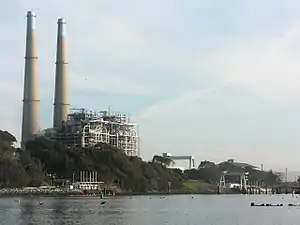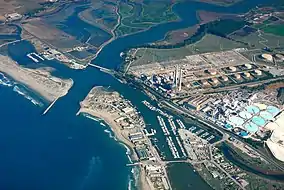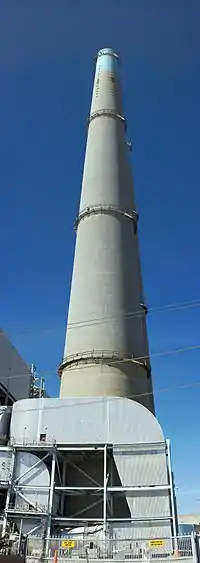Moss Landing Power Plant
The Moss Landing Power Plant is a natural gas powered electricity generation plant located in Moss Landing, California, United States, at the midpoint of Monterey Bay. Its large stacks are landmarks, visible throughout the Monterey Bay Area. The plant is owned and operated by Houston-based Dynegy and currently has a generation capacity of 1020 MW (net) from its two combined cycle generation units.[3] It was once the largest power plant in the state of California, with a generation capacity of 2560 MW, before its two large supercritical steam units were taken offline.
| Moss Landing Power Plant | |
|---|---|
 Moss Landing Power Plant, with its highly visible stacks | |

| |
| Country | United States |
| Location | Moss Landing, California |
| Coordinates | 36°48′17.54″N 121°46′55.19″W |
| Status | Operational |
| Commission date | 1950 |
| Owner(s) | Dynegy |
| Thermal power station | |
| Primary fuel | Natural gas |
| Combined cycle? | Yes |
| Power generation | |
| Units operational | 2 x 530 MW |
| Units decommissioned | 7 |
| Nameplate capacity | 1,060 MW |
| Annual net output | 4,179 GWh (2018) [1] |
| Storage capacity | 567.5 MW (starting late 2020)[2] |
| External links | |
| Commons | Related media on Commons |


It is to be the site of a new battery storage power station for grid battery storage of over 567MW / 2,270MWh of power, potentially the world's largest when completed.[2]
History
In 1949, Pacific Gas & Electric (PG&E) began construction on the Moss Landing Power Plant. Five natural gas and oil powered steam units were built during the 1950s. Commercial generation started in 1950 with a capacity of 613 MW.
In 1964, the construction of two additional units began (6 and 7), with two new 500-foot (150 m) stacks. These two units had a capacity of 750 MW each for a total of 1500 MW, with 180 feet (55 m) tall boilers. They employed a newer technology using supercritical steam at 3,600 psi (25 MPa).
In 1995, the original five units were retired, and in 1997 PG&E let the permits lapse for these units.[4]
As part of the Deregulation of Utilities in California, PG&E sold the plant to Duke Energy (DENA) in 1998. To comply with more restrictive pollution regulation, units 6 and 7 were upgraded in 1998 with a selective catalytic reduction unit and digital control systems.
Starting in 2000, the eight 225-foot (69 m) stacks and 19 fuel oil storage tanks were removed, and two new units were built on the former site. The new units 1 and 2 were brought online in 2002. They are combined cycle units, 50% more efficient than the other units, because they use two turbines: first, a pair of 170 MW gas turbines, then a 190 MW steam turbine, for a total of 530 MW each. When completed in 2002, the plant was the largest power plant in California by capacity, at 2560 MW.[5]
In 2006, having invested over half a billion dollars in upgraded capacity, efficiency and emission control, Duke Energy sold the plant to LS Power Equity Partners.[6][7] Dynegy then purchased the plant in April 2007 along with other assets of LS partners.[8]
On December 31, 2016, Dynegy retired supercritical steam units 6 and 7 as they were no longer economically competitive. However, Dynegy continues to maintain the permit on these units.[9]
In February 2017, independent power producer Dynegy, Inc. announced that it may close the gas plant, due to market conditions resulting from a glut of wholesale electricity capacity in California making it difficult to operate profitably.[10] By 2018, California had 7,000 MW of surplus generating capacity, but a similar amount (mostly ocean cooled) would be retired by 2021.[11] The glut in wholesale prices is partially a result of policies which guarantee utilities like PG&E (a regulated monopoly) a return on investment for building new power plants, even when they are not needed. Independent power producers like Dynegy, on the other hand, do not have a guaranteed return on their investment.[10] Power production has dropped considerably, reducing taxes paid to Monterey County.[12]
Grid connection
The plant has power lines that connect it to Path 15, and interconnections like Path 26 and Path 66 that allow power to flow to far-away regions. The plant is also connected to local loads and the San Jose region by transmission lines.
Gas units
Both the supercritical units and the combined cycle units use once-through cooling. The supercritical units have a cooling requirement of 600,000 US gallons (2,300 m3) per minute, and the combined cycle units a requirement of 250,000 US gallons (950 m3).[4]
Supercritical Steam Units 6 and 7
Units 6 and 7 used supercritical steam. These units were retired at the end of 2016. At the end of their life, units 6 and 7 were typically operated as peaking units when demand for electricity was highest. In 2016, the last year of operation, they only operated approximately 3% of the time.[9]
The generation process for units 6 and 7 starts with natural gas injected at one end of the boiler to be burned. Primary water is injected at the other end of the boiler to receive the heat produced. The gas simply comes from a natural gas pipeline, and combustion products go up the stack and into the atmosphere. Water has a much more complicated path, and consists of two distinct systems: coolant water and primary (steam-generating) water. Cooling water is pumped out of the Monterey Bay or the nearby Elkhorn Slough. Then it is purified, used to cool down the water coming from the turbines, and discharged into the ocean. Steam for the turbines is created from the primary water flow, which is preheated before entering the boiler. From the boiler, the superheated steam is directed into a first turbine working at high pressure, then into a low pressure turbine. The turbines drive the generators.
Combined Cycle Units 1 and 2
Combustion products drive the gas turbines directly. First, air is drawn from the air intake to the compressor (driven by the turbine axle), then it is burned with natural gas in the combustion chamber. The hot combustion gasses then go through the actual turbine (driving the axle). From a thermodynamic standpoint, this is the standard Brayton cycle. Because the gas turbine does not transfer energy from the combustion process to the turbine via steam, it avoids the cost, energy loss and environmental impact of the primary water cycle.
At the output of the gas turbines, some of the remaining energy (heat) in the exhaust gas is recovered through a heat exchanger and transferred to water that feeds a steam turbine, similar to units 6 and 7.
On a smaller scale than the supercritical units, units 1 and 2 are also more flexible, with a start-up time of only an hour, against 24 hours for units 6 and 7.
Battery storage
Utilities in California are required by a 2013 law to provide significant battery storage by 2024.[13]
Vistra 500 kV
On June 29, 2018, Vistra Energy, which merged with Dynegy on April 9, 2018,[14] announced that it will develop a 300 MW / 1,200 MWh energy storage system to be located at Moss Landing, using the existing turbine building and existing interconnection from units 6 and 7, connecting to the 500 kV grid.[15] Vistra Energy expects the energy storage system to begin commercial operation by the end of 2020, pending receipt of approval from California Public Utilities Commission (CPUC). This would be the largest lithium-ion battery energy storage system in the world.[16] The project began construction in December 2019,[17] and began operating at the end of 2020.[18] An expansion to 1,500 MW/6,000 MWh (also connecting to the 500 kV grid) was approved in August 2020, but not decided.[19][20]
Elkhorn 115 kV
Pacific Gas & Electric (PG&E) asked the CPUC to approve four energy storage projects located at Moss Landing including another large lithium-ion battery storage system of 182.5 MW / 730 MWh ("Elkhorn") to be provided by Tesla and owned and operated by PG&E, connecting to the regional 115 kV grid.[21][22][23] In February 2020, the Monterey County Planning Commission unanimously approved the project, which was initially scheduled to start construction in late March[24] and be complete by 2021.[25] However, the COVID-19 pandemic in California and subsequent stay-at-home order forced the project to be delayed.[24] Construction began in July 2020.[26] When the Moss Landing project is completed, it will double the energy storage available in California.[27]
See also
| Wikimedia Commons has media related to Moss Landing Power Plant. |
References
- "Electricity Data Browser - Dynegy Moss Landing Power Plant". www.eia.gov. Retrieved 2020-02-03.
- Spector, Julian (2018-11-08). "PG&E's Record-Breaking Battery Proposal Wins Approval From Regulators". Greentech Media. Archived from the original on 2020-08-10.
four projects, totaling 567.5 megawatts/2,270 megawatt-hours … includes … 182.5-megawatt/730-megawatt-hour Tesla system that PG&E would own at a substation nearby.
- "Dynergy Generating Assets" (PDF). February 2018. Retrieved May 28, 2018.
- "Final Staff Assessment- Moss Landing Power Plant Project" (PDF). California Energy Commission. June 2000. Retrieved May 28, 2018.
- "Duke Energy Breaks Ground on Moss Landing Modernization Project". Duke Energy. November 16, 2000. Archived from the original on July 2, 2004.
- "Duke Energy Completes Sale of Wholesale Generation Assets to LS Power". press release. May 4, 2006. Archived from the original on September 27, 2011. Retrieved February 16, 2011.
- "LS Power Closes Deal for Duke Assets". press release. May 4, 2006. Retrieved May 28, 2018.
- "Dynegy Announces Completion of LS Power Transaction". press release. April 2, 2007. Retrieved May 28, 2018.
- "Moss Landing power plant's tall twin towers are off, but permits remain". Monterey County Weekly. February 23, 2017. Retrieved May 28, 2018.
- Penn, Ivan; Menezes, Ryan (2017-02-05). "Californians are paying billions for power they don't need". Los Angeles Times. Archived from the original on 2017-02-22. Retrieved 2017-12-30.
California has a big — and growing — glut of power, an investigation by the Los Angeles Times has found. The state's power plants are on track to be able to produce at least 21% more electricity than it needs by 2020, based on official estimates. And that doesn't even count the soaring production of electricity by rooftop solar panels that has added to the surplus.
Utilities are typically guaranteed a rate of return of about 10.5% for the cost of each new plant regardless of need. This creates a major incentive to keep construction going: Utilities can make more money building new plants than by buying and reselling readily available electricity from existing plants run by competitors.
- Spector, Julian (2018-01-15). "PG&E Must Solicit Energy Storage and DERs to Replace 3 Existing Gas Plants". Greentech Media. Archived from the original on 2020-09-02.
The California ISO has about 7,000 megawatts of surplus capacity [in 2018]. .. about 7,000 megawatts of older plants are already set to retire by 2021 due to a regulation on plants that use ocean water for cooling.
- Cortez, Felix (27 February 2020). "Tesla battery power plant approved in Moss Landing". KSBW. Archived from the original on 25 July 2020.
“It’s huge for the area and as you know the power plant has been gradually shutting down and they producing about one-tenth of the power they used to produce in the past and that hurts us from a tax standpoint,” said Monterey County Supervisor John Phillips.
- "PG&E, Tesla Break Ground on Landmark Battery Energy Storage System | PG&E". www.pge.com. July 29, 2020. Retrieved 2021-02-06.
- "Vistra / Dynegy Merger - Vistra Energy". Vistra Energy. Retrieved 2018-07-03.
- "Monterey County - File #: PC 19-019, PLN180394. Exhibit B - Discussion draft". monterey.legistar.com. Monterey County. 2019-03-20. p. 5.
- "Vistra Energy to Develop 300-Megawatt Battery Storage Project in California". investor.vistraenergy.com. Retrieved 2018-07-03.
- Hering, Garrett (2020-04-17). "Despite COVID-19, 300-MW Calif. battery array expected online in 2020". www.spglobal.com. Retrieved 2020-07-24.
- Colthorpe, Andy (7 January 2021). "At 300MW / 1,200MWh, the world's largest battery storage system so far is up and running". Energy Storage News. Archived from the original on 28 January 2021.
- "Vistra approved to build a grid battery bigger than all utility-scale battery storage in the US combined". pv magazine USA. 13 August 2020. Archived from the original on 2020-09-04.
- "Dynegy Moss Landing LLC (Vistra Energy) / IS_PLN190253". ceqanet.opr.ca.gov. Monterey County. 2020-05-15. p. 9.
transform the voltage between the 34.5 kV power conversion systems and the 500 kV transmission systems. The substations would contain the 500 kV transformer control house and associated breakers, switches, and miscellaneous equipment necessary to tap into existing 500 kV line.
- "Advice Letter 5322-E from PG&E to CPUC" (PDF). Retrieved July 3, 2018.
- "Tesla strikes another mammoth energy storage deal in California". Ars Technica. Retrieved 2018-07-03.
- "Monterey County - File #: PC 20-013, PLN180371. Exhibit B - Discussion draft". monterey.legistar.com. 2020-02-14. pp. 2–4.
The BESS project will have the capacity to dispatch up to 730 megawatt hours (MWh) of energy to the electrical grid at a maximum rate of 182.5 MW for up to 4 hours during periods of high demand. The purpose of the Elkhorn Battery Energy Storage System (BESS) Project (project) is to enable PG&E to provide reliable and flexible power to the electrical system at and around PG&E’s Moss Landing Substation, which serves the South Bay-Moss Landing local sub-area, spanning Silicon Valley to the central coast.
- Hering, Garrett (2020-03-26). "US battery storage boom hits COVID-19 roadblock as project delays mount". www.spglobal.com. Retrieved 2020-07-24.
Pacific Gas and Electric Co.'s 182.5-MW Tesla Moss Landing Battery Energy Storage Project (Elkhorn), for instance, a marquee project planned near the shores of California's Monterey Bay, was on track to start construction in late March. That will not happen now as Pacific Gas and Electric, or PG&E, has postponed groundbreaking "until after the stay-at-home order is lifted," according to Paul Doherty, a spokesperson for the utility.
- "Elkhorn Battery Storage Facility - Mitigated Negative Declaration". Monterey County. 2019-07-02. p. 7.
Construction for the project is anticipated to begin in late 2019 and early 2020, with closing-out activities continuing through summer 2021.
- "PG&E, Tesla begin construction on one of the world's largest batteries". pv magazine USA. 29 July 2020. Archived from the original on 2020-09-29.
- Katz, Cheryl (December 15, 2020). "In Boost for Renewables, Grid-Scale Battery Storage Is on the Rise". Yale E360. Retrieved 2021-02-06.